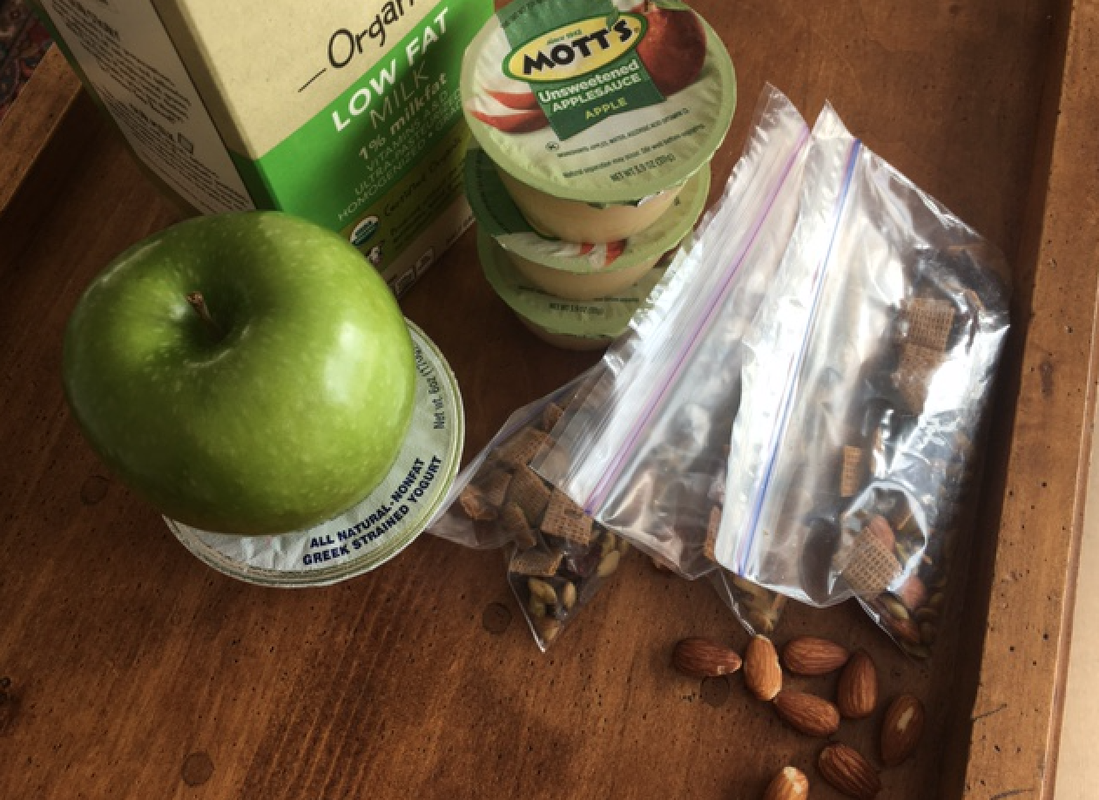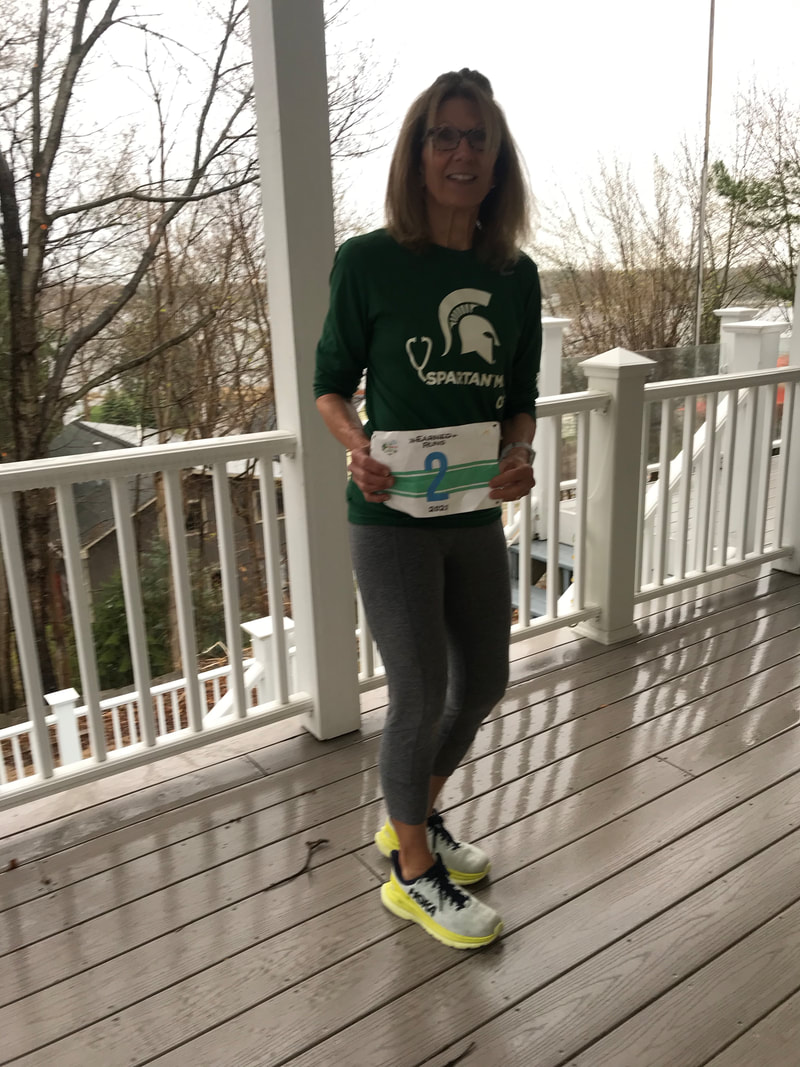BLOG
|
|
AFTER-RUN SNACKS Make your own to help increase intake of healthy foods/nutrients! You won’t need to purchase bars or trail mixes that often rely heavily on peanuts; introduce a variety of heart friendly nuts and seeds into your diet. If done DIY-style and left loose in a bag, there’s no need for a “binding” element to maintain ingredients in a rigid bar form, which tends to add fat or sugar calories.
Earned Runs SAMPLE HOMEMADE “NUT/SEED” SNACK Food Item protein g fat g carb g calories 2 halves walnut 0.6 2.6 0.5 28 4 almonds 1.0 2.4 1.0 30 1TBSP dried cranberries, cherries, or blueberries <1 0.0 15.0 60 1 tsp pumpkin or sunflower seeds, roasted 1.5 3.2 0.7 38 1TBSP Wheat Chex 0.6 <1 5.0 29 or other dry cereal 1 tsp mini-chips special Hershey’s dark chocolate <1 1.5 3.0 29 Total -approximate 4.7 10.5 24.5 214 (Calculations are based on general values for these foods; exact figures will vary) Combine the ingredients above in a small seal-able bag or container. Make up a week’s worth and grab one serving each morning to consume after a run, cross training, or exercise activity. Eat it as is, stir onto yogurt, add milk, or sprinkle on a snack-cup of natural unsweetened applesauce. The recipe can be tweaked per preference, allergies, and availability. But you get the idea. This sample combination tries to incorporate fruits with anti-oxidant properties and adds a sweet chocolate treat that is also considered healthy. Whole grains are added as fortified dry cereal. The serving is small, to avoid calorie “creep” from eating too much of a good thing. At the end of 7 days you will have added “nuts/seeds” group and to your diet every day, without spending too many extra calories. WHY? Recently, research news on the American diet published March 7, 2017 in the Journal of the American Medical Association (JAMA) made headlines and TV broadcasts. Modeling and analysis of data gathered from various sources including the National Center for Health Statistics and the National Health and Nutrition Examination Surveys were used to “estimate associations of intake of 10 specific dietary factors with mortality due to heart disease, stroke, and type 2 diabetes” among US adults. The researchers described this type of death cause as “cardiometabolic”. About 17,000 dietary habit surveys were used in in the risk assessment model, roughly 8,000 each from 1999-2002 and 2009-2012. The study looked at “consumption of 10 foods/nutrients associated with cardiometabolic diseases: fruits, vegetables, nuts/seeds, whole grains, unprocessed red meats, processed meats, sugar-sweetened beverages (SSBs), polyunsaturated fats, seafood omega-3 fats, and sodium” Among the findings of the study were indications that significant numbers of diet-related deaths were associated with NOT EATING ENOUGH (“sub-optimal” amounts) of certain healthy foods. Mentioned in the research article were “low nuts/seeds”, “low vegetables”, “low seafood omega-3 fats”, and “low fruits”. Of course, eating TOO MUCH of the usual suspect unhealthy foods was also highlighted as being associated with cardiometabolic deaths; “high sodium”, “high processed meats”, and “high SSBS”. An editorial in the same issue of JAMA pointed out the weaknesses of this kind of approach to identifying factors related to disease and death. It also commented on the smaller print findings that were not as widely reported, that the diet-related risks were greater among certain groups (men more than women, blacks and Hispanics more than whites, adults with low education than with high education). That deaths related to “high SSBs”, “low polyunsaturated fats”, and “low whole grains”, had declined from 2002-2012. Bottom line: there is no guarantee the diet prescription suggested by this research is the secret to a long, disease-free life. Exercise, stresses, relationships, environmental exposures, genetics, and other known and as yet unknown factors exert influences on health status. However, if we try to copy what seems to work for others, this research provides some nutrition direction. RUN HAPPY! If you aren’t concerned with calories and are looking for more adventurous mixes, check out the article “4 Energizing Trail Mix Recipes for On The Go” by Emily Polachek for Competitor.com. http://jamanetwork.com/journals/jama/article-abstract/2608221 http://jamanetwork.com/journals/jama/article-abstract/2608201 https://www.ncbi.nlm.nih.gov/pmc/articles/PMC3257681/ http://www.mayoclinic.org/diseases-conditions/heart-disease/in-depth/nuts/art-20046635?pg=2 http://running.competitor.com/2016/06/nutrition/energizing-trail-mix-recipes-for-on-the-go_151720
0 Comments
Your comment will be posted after it is approved.
Leave a Reply. |
BRIDGE TO PHYSICAL SELF
Running, walking, and fitness activities enable us to experience our physical selves in a world mostly accessed through use of fingers on a mobile device. AuthorEARNED RUNS is edited and authored by me, runner and founder. In 1978 I began participating in 10K road races before 5Ks were common. I've been a dietitian, practiced and taught clinical pathology, and been involved with research that utilized pathology. I am fascinated with understanding the origins of disease as well as health and longevity. Archives
November 2023
CategoriesNew! Search Box
Earned Runs is now searchable! Check it out...
|


 RSS Feed
RSS Feed